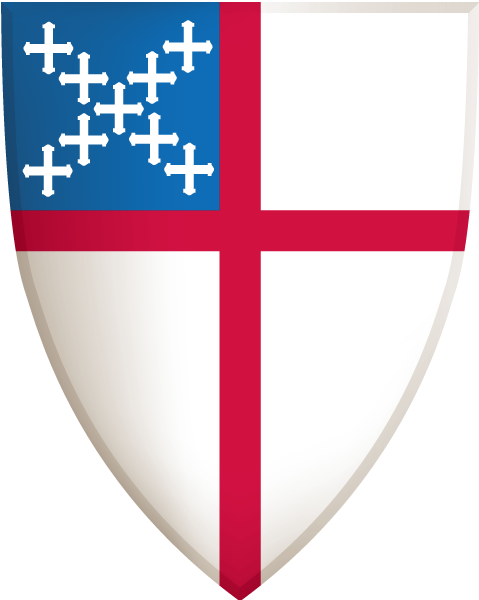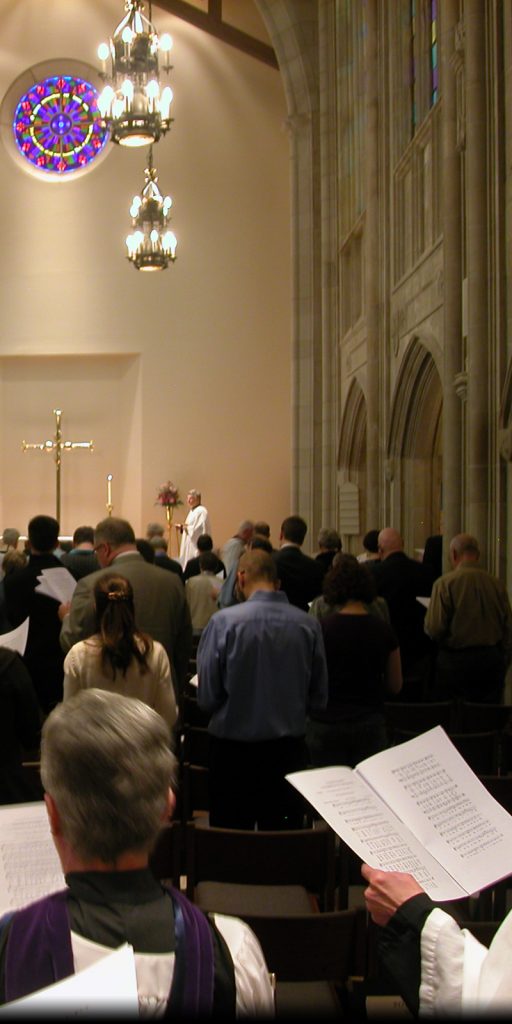The Altar Party and the Order of the Procession
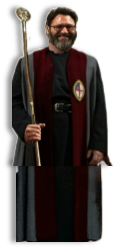 Verger – A lay minister who assists the clergy in the conduct of public worship, especially in the marshaling of processions. Vergers may be full-time or part-time, paid or volunteer. The history of the verger dates back to the middle ages when the verger was the “Protector of the Procession.” He would lead the way, making room for the procession to enter the church from the town square, and with his virge (mace) in hand would literally clear the way if necessary. In the middle ages, a verger might have needed to use his virge to keep back animals or an overenthusiastic crowd from the personage he was escorting or even to discipline unruly choristers. The basic vestment of the verger is a black cassock. It is common for a verger’s gown to bear the arms of the church, usually on one or both sleeves. It can be trimmed with velvet, which may be in another color.
Verger – A lay minister who assists the clergy in the conduct of public worship, especially in the marshaling of processions. Vergers may be full-time or part-time, paid or volunteer. The history of the verger dates back to the middle ages when the verger was the “Protector of the Procession.” He would lead the way, making room for the procession to enter the church from the town square, and with his virge (mace) in hand would literally clear the way if necessary. In the middle ages, a verger might have needed to use his virge to keep back animals or an overenthusiastic crowd from the personage he was escorting or even to discipline unruly choristers. The basic vestment of the verger is a black cassock. It is common for a verger’s gown to bear the arms of the church, usually on one or both sleeves. It can be trimmed with velvet, which may be in another color.

Thurifer – The server or acolyte who carries and swings the thurible in which incense is burned during the eucharist and other liturgies. The thurifer, the presider (celebrant), the deacon, or other ministers may use the thurible in the ceremonial censing of people or objects such as the gospel book or altar. The thurifer may be assisted by another minister, a “boat person,” who carries the incense boat or container which holds the incense that will be used during the service.

Crucifer – The Crucifer is a person appointed to carry a processional cross – a cross or crucifix with a long staff – during processions at the beginning of the service, at the Gospel procession, and at the end of the service. They may also light candles and extinguish them before and after the service.

Torch bearers – An acolytes or servers who carry torches representing the “Light of Christ” in procession at the beginning of the service, at the Gospel procession, and at the end of the service. They may also light candles and extinguish them before and after the service.

Cantor – A cantor is a singer who sets the pitch and leads the liturgical singing of psalms, canticles, anthems, and other sung texts. At the Chapel, a Cantor joins the procession on Sundays during Lent when the Great Litany is sung. Cantors also often lead unaccompanied singing. In responsorial recitation of the Psalter, the cantor sings the verses of the psalm and the congregation sings a refrain after each verse or group of verses.
 Eucharistic Ministers – A Eucharistic Minister is layperson licensed by the bishop to administer the consecrated elements of the eucharist. Eucharistic ministers may be licensed to administer the consecrated bread and wine at any celebration of the eucharist in the absence of a sufficient number of priests and deacons to assist the celebrant. They may also be licensed to go from a Sunday eucharist or other principal celebrations of the eucharist to share the sacrament with members of the congregation who were unable to be present at the celebration because of illness or infirmity. Eucharistic ministers may be licensed for either or both ministries. This ministry is understood to be an extraordinary ministry, and is not to take the place of the ministry of priests and deacons concerning the administration of the eucharist. Prior to the current lay ministry canons, Eucharistic Ministers were known as “Lay Eucharistic Ministers. Prior to that, specially licensed lay readers administered the chalice at the eucharist and were known as “chalice bearers.”
Eucharistic Ministers – A Eucharistic Minister is layperson licensed by the bishop to administer the consecrated elements of the eucharist. Eucharistic ministers may be licensed to administer the consecrated bread and wine at any celebration of the eucharist in the absence of a sufficient number of priests and deacons to assist the celebrant. They may also be licensed to go from a Sunday eucharist or other principal celebrations of the eucharist to share the sacrament with members of the congregation who were unable to be present at the celebration because of illness or infirmity. Eucharistic ministers may be licensed for either or both ministries. This ministry is understood to be an extraordinary ministry, and is not to take the place of the ministry of priests and deacons concerning the administration of the eucharist. Prior to the current lay ministry canons, Eucharistic Ministers were known as “Lay Eucharistic Ministers. Prior to that, specially licensed lay readers administered the chalice at the eucharist and were known as “chalice bearers.”
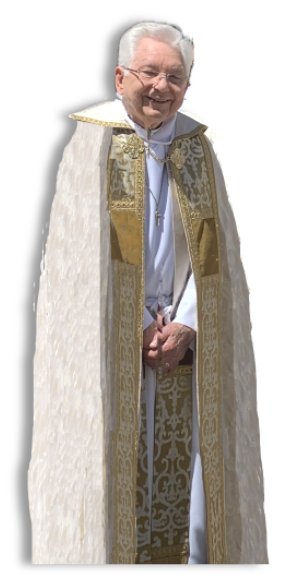
Assisting Clergy – Assisting clergy can include a deacon or a priest. A deacon carries the Gospel Book in procession, reads the Gospel, sets the table, invites the confession of sin, serves bread or wine, and offers the dismissal. An assisting priest may do any of the aforementioned and may concelebrate with the presider (celebrant). Joint celebration of the eucharist by a chief presider (celebrant) and one or more concelebrants. Concelebration may or may not include recitation of all or part of the eucharistic prayer by the concelebrants.
 Presider (celebrant) – The Presider is the bishop or priest who presides at the eucharist and at baptism, and at other sacramental and liturgical occasions. The more recent liturgical materials of the Episcopal Church have employed the word “Presider” over the word “Celebrant.” The theological thinking is that everyone at a service of Holy Eucharist is celebrating, while one presides at the Eucharist. In the ancient church, the term “President” was used to describe the one who presides at the Eucharist. An early draft of the 1979 Book of Common Prayer was set to utilize the term “President” over the term “Celebrant.” Shortly before these draft materials were to be released, the Watergate scandal broke, causing the liturgical commission to restore the term Celebrant. Since 1985, subsequent liturgical materials released by the Episcopal Church have utilized the term “Presider” instead.
Presider (celebrant) – The Presider is the bishop or priest who presides at the eucharist and at baptism, and at other sacramental and liturgical occasions. The more recent liturgical materials of the Episcopal Church have employed the word “Presider” over the word “Celebrant.” The theological thinking is that everyone at a service of Holy Eucharist is celebrating, while one presides at the Eucharist. In the ancient church, the term “President” was used to describe the one who presides at the Eucharist. An early draft of the 1979 Book of Common Prayer was set to utilize the term “President” over the term “Celebrant.” Shortly before these draft materials were to be released, the Watergate scandal broke, causing the liturgical commission to restore the term Celebrant. Since 1985, subsequent liturgical materials released by the Episcopal Church have utilized the term “Presider” instead.
Vestments
Vestments are the distinctive garments worn by leaders of the church’s worship. Many of the church’s vestments are descended from the ordinary dress of the imperial Roman society in which the early church came into being.
Vestments worn by the celebrant at the eucharist typically include a stole and chasuble. These vestments usually reflect the liturgical color of the day or season of the celebration. The celebrant also usually wears an alb and may wear a girdle and amice. The officiant at the Daily Office or other non-eucharistic services may wear a cassock and surplice. A tippet may also be worn. A stole indicates that the wearer is an ordained person. Bishops and priests wear the stole over both shoulders, and deacons typically wear the stole over the left shoulder. Bishops may wear distinctive episcopal vestments, including the rochet and chimere, and the miter. A purple shirt with a clerical collar usually indicates that the wearer is a bishop, and a black shirt with a clerical collar usually indicates that the wearer is a member of the clergy.
Lay servers, acolytes, lectors, and choir members may also wear vestments at worship. According to local custom, they may wear an alb, or a cassock with surplice or cotta.
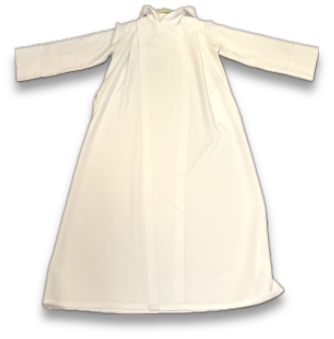
Alb – An alb is a long white garment with narrow sleeves, which is the basic garment worn by ordained and lay ministers at the eucharist and at other church services. The alb (from Latin alba, meaning white) is derived from the undertunic of the Greeks and Romans of the fourth century. It may be girded at the waist.
 Cincture – A cincture is a rope-like article worn over an alb to gird it at the waist. For bishops and priests, they are knotted in such a fashion that the stole is also secured by the cincture.
Cincture – A cincture is a rope-like article worn over an alb to gird it at the waist. For bishops and priests, they are knotted in such a fashion that the stole is also secured by the cincture.

Stole – A stole indicates that the wearer is an ordained person. Bishops and priests wear the stole over both shoulders, and deacons typically wear the stole over the left shoulder.
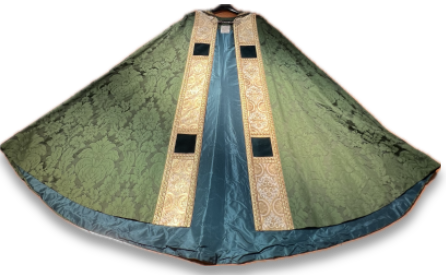
Cope – A full-length cloak formed from a semicircular piece of cloth, it is open at the front and is fastened at the breast by hooks or a brooch. Worn by bishops and priests.
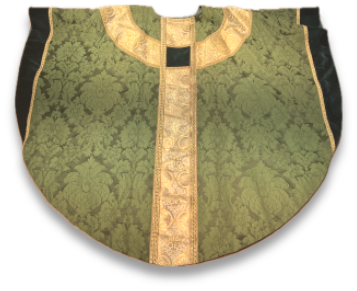 Chasuble – The sleeveless outer vestment worn by the celebrant at the eucharist. The chasuble and cope are both derived from the outdoor cloak worn by all classes and both sexes in the Greco-Roman world. The chasuble may be oval or oblong, with an opening for the head. It typically reflects the liturgical color of the day. Chasubles vary widely in fabric and style. They may be plain cloth or decorated with orphreys or symbols.
Chasuble – The sleeveless outer vestment worn by the celebrant at the eucharist. The chasuble and cope are both derived from the outdoor cloak worn by all classes and both sexes in the Greco-Roman world. The chasuble may be oval or oblong, with an opening for the head. It typically reflects the liturgical color of the day. Chasubles vary widely in fabric and style. They may be plain cloth or decorated with orphreys or symbols.

Dalmatic / Tunicle – A dalmatic is the distinctive vestment of deacons in the western church. By the late middle ages, deacons (or, more commonly, priests acting as liturgical deacons) were wearing a short dalmatic in the color of the day, ornate in fabric, adorned with orphreys (two vertical and two horizontal), with narrow sleeves, and open at the sides. When worn by a layperson, it is worn without a stole and called a tunicle.
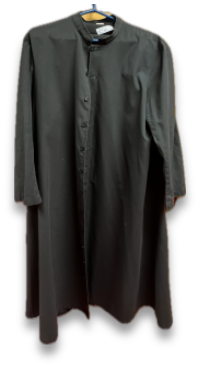
Cassock – A long, close-fitting garment with narrow sleeves worn by clergy and other ministers. Cassocks are typically black but also may be blue, gray, or red. Bishops may wear purple cassocks. It may be worn under a surplice. Historically, the cassock was the street garb of a person in clerical orders. It was part of the outdoor dress of Anglican clergy until the beginning of the nineteenth century.
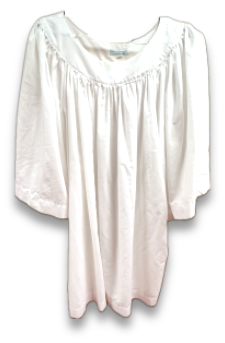 Surplice – A surplice is a white outer vestment worn by clergy, acolytes, choristers, or other participants services at the Chapel. It is a loose garment, usually with full sleeves. It is a modified alb, the surplice probably originated in the 11th century in France or England, where the girdled alb was given up in the cold climate and the surplice was worn for uniform appearance over fur-lined garments. It was adopted in Rome in the 13th century. After the Protestant Reformation (16th century), the surplice was retained by the Church of England, and it is the most common vestment worn by Anglican and many Lutheran clergymen. It has no counterpart in the Eastern churches.
Surplice – A surplice is a white outer vestment worn by clergy, acolytes, choristers, or other participants services at the Chapel. It is a loose garment, usually with full sleeves. It is a modified alb, the surplice probably originated in the 11th century in France or England, where the girdled alb was given up in the cold climate and the surplice was worn for uniform appearance over fur-lined garments. It was adopted in Rome in the 13th century. After the Protestant Reformation (16th century), the surplice was retained by the Church of England, and it is the most common vestment worn by Anglican and many Lutheran clergymen. It has no counterpart in the Eastern churches.
